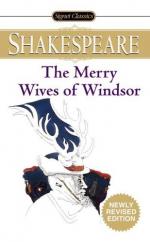|
This section contains 9,531 words (approx. 32 pages at 300 words per page) |

|
SOURCE: "The Meaning of Falstaff's Allusion to the Jack-a-Lent in The Merry Wives of Windsor " in Studies in Philology, Vol. 88, No. 1, Winter, 1991, pp. 46-68.
In the essay below, Jonassen identifies Falstaff as a "Jack-a-Lent," or scapegoat, who satirizes the powerful forces in the community even while he is himself being humiliated, thus restoring balance to the world of the play in the end.
I: the Allusion to the Jack-a-lent
The first time Sir John appears in 2 Henry IV, he is with his diminutive page who totters under the weight of Falstaff's huge "sword and buckler" (1.2.1-54).1 Aware of how the tiny figure accentuates his own bulk, Sir John calls the boy a "giant," and comments, "Men of all sorts take a pride to gird at me, . . . If the Prince put thee into my service for any other reason than to set me off, why then I have no...
|
This section contains 9,531 words (approx. 32 pages at 300 words per page) |

|


